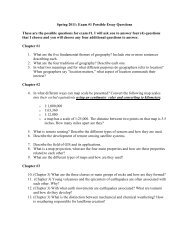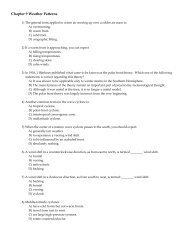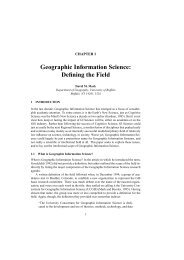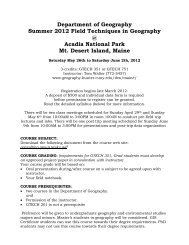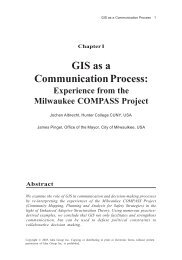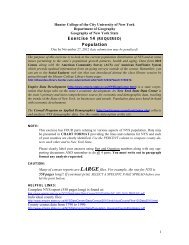Spring 2012: Exam #1 Possible Essay Questions These are the ...
Spring 2012: Exam #1 Possible Essay Questions These are the ...
Spring 2012: Exam #1 Possible Essay Questions These are the ...
Create successful ePaper yourself
Turn your PDF publications into a flip-book with our unique Google optimized e-Paper software.
<strong>Spring</strong> <strong>2012</strong>: <strong>Exam</strong> <strong>#1</strong> <strong>Possible</strong> <strong>Essay</strong> <strong>Questions</strong><br />
<strong>These</strong> <strong>are</strong> <strong>the</strong> possible questions for exam <strong>#1</strong>. I will ask you to answer five (5) questions that<br />
I choose and you will choose any four additional questions to answer.<br />
Chapter <strong>#1</strong><br />
1. What <strong>are</strong> <strong>the</strong> five fundamental <strong>the</strong>mes of geography? Include one or more sentences<br />
describing each.<br />
2. What <strong>are</strong> <strong>the</strong> four traditions of geography? Describe each one.<br />
3. In what two meanings and for what different purposes do geographers refer to location?<br />
When geographers say "location matters," what aspect of location commands <strong>the</strong>ir<br />
interest?<br />
Chapter #2<br />
4. In what different ways can map scale be presented? Convert <strong>the</strong> following map scales<br />
into <strong>the</strong>ir verbal equivalents using an centimeter ruler and converting to kilometers.<br />
o 1:1,000,000<br />
o 1:63,360<br />
o 1:12,000<br />
o a map has a scale of 1:25,000. The distance between two points on that map is 3.5<br />
inches. How many miles apart <strong>are</strong> <strong>the</strong>y?<br />
5. What is remote sensing? Describe <strong>the</strong> different types of sensors and how <strong>the</strong>y <strong>are</strong> used.<br />
6. Describe <strong>the</strong> development of remote sensing satellite systems.<br />
7. What is a map projection, what <strong>are</strong> <strong>the</strong> four main properties and how <strong>are</strong> <strong>the</strong>se properties<br />
related to each o<strong>the</strong>r?<br />
Chapter #3<br />
8. (Chapter 3) What <strong>are</strong> <strong>the</strong> three classes or main groups of rocks and how <strong>are</strong> <strong>the</strong>y formed?<br />
9. (Chapter 3) Young volcanoes and <strong>the</strong> epicenters of earthquakes <strong>are</strong> often associated with<br />
each o<strong>the</strong>r. Why?<br />
10. (Chapter 3) With what earth movements <strong>are</strong> earthquakes associated? What <strong>are</strong> tsunami<br />
and how do <strong>the</strong>y develop?<br />
11. (Chapter 3) What is <strong>the</strong> distinction between mechanical and chemical wea<strong>the</strong>ring? How<br />
is wea<strong>the</strong>ring responsible for landform creation?<br />
Chapter #4
12. (Chapter 4) What is relative humidity? How is it affected by changes in air temperature?<br />
What is <strong>the</strong> dew point?<br />
13. (Chapter 4) Draw and label a diagram of earth's global wind and pressure belts. Why do<br />
<strong>the</strong> winds and pressure belts occur where and <strong>the</strong> way <strong>the</strong>y do?<br />
14. (Chapter 4) What determines <strong>the</strong> amount of insolation (energy) received at a given point<br />
on <strong>the</strong> earth’s surface? Does all potentially receivable solar energy actually reach <strong>the</strong><br />
earth's surface? Why?<br />
15. (Chapter 4) How is <strong>the</strong> atmosphere heated? What is <strong>the</strong> environmental lapse and what<br />
does it indicate about <strong>the</strong> atmospheric heat source?<br />
16. (Chapter 4) What is <strong>the</strong> relationship between atmospheric pressure and surface<br />
temperature? What is a pressure gradient and of what concern is it in wea<strong>the</strong>r<br />
forecasting?<br />
17. (Chapter 4) In what way do land and water <strong>are</strong>as respond differently to equal insolation<br />
(energy) inputs? How <strong>are</strong> <strong>the</strong>se responses related to atmospheric temperatures and<br />
pressures?<br />
18. (Chapter 4) What <strong>are</strong> air masses? What is a front? Describe <strong>the</strong> development of a midlatitude<br />
low pressure system showing how it relates to air masses and fronts.<br />
19. (Chapter 4) Summarize <strong>the</strong> temperature and rainfall characteristics of four (4) <strong>the</strong><br />
following climates:<br />
o Tropical Wet (Af)<br />
o Tropical Wet & Dry (Aw)<br />
o Desert (BW)<br />
o Mediterranean (Cs)<br />
o Humid Continental (Dfa)<br />
o Subarctic (Dfc/d)<br />
o Tundra (ET)<br />
20. (Chapter 4) What causes <strong>the</strong> greenhouse effect? What impact might it have on <strong>the</strong> earth's<br />
environment?



